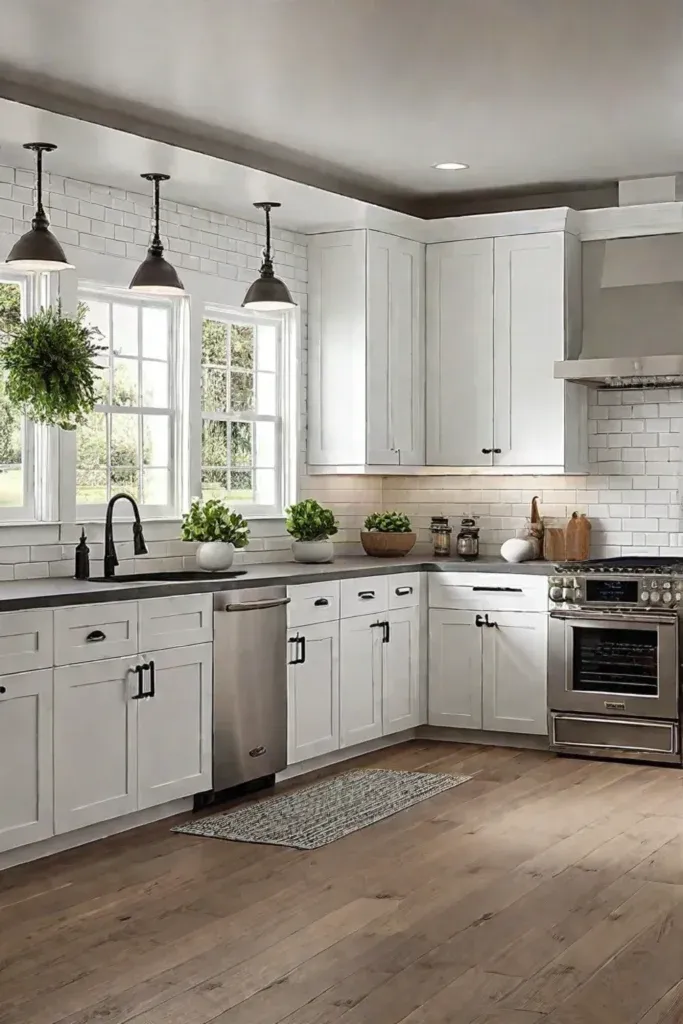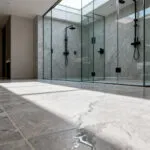As a bohemian spirit with an eye for the unconventional, I’ve always been drawn to homes that transcend mere function to become living works of art. And in my humble opinion, no room better encapsulates this philosophy than the traditional kitchen – a space where culinary craft meets thoughtful design.
The masterful interplay of lighting fixtures is at the heart of every artfully curated traditional kitchen. From the warm embrace of a chandelier’s glow to the focused utility of under-cabinet illumination, each element works symphonic harmony to create an environment that nourishes both body and soul.

Join me as we explore the nuanced tapestry of lighting that breathes life into the traditional kitchen, transforming it into a canvas for your most inspired culinary expressions.
Chandeliers: A Timeless Centerpiece
As a lover of traditional design, I can’t help but swoon over the elegance a chandelier brings to a kitchen. This stunning lighting fixture provides ambient illumination and sets the tone for the entire space, making it the perfect centerpiece for your culinary haven.

Selecting the Right Size
When it comes to choosing a chandelier, size matters. You want something that complements the scale of your kitchen without overwhelming the space. Generally, opt for a chandelier roughly one-third the width of your kitchen table. This ensures it casts a warm, inviting glow over your dining area without feeling too imposing.
Styles and Finishes
The beauty of chandeliers lies in their diverse styles and finishes. For a touch of timeless glamour, consider a classic crystal chandelier. These sparkling beauties add a touch of elegance and sophistication, catching and reflecting light in a mesmerizing dance. If you’re drawn to a more rustic charm, a wrought iron chandelier might be the perfect fit, bringing a warm, cozy vibe to your traditional kitchen.
Practical tips: Hang your chandelier above the kitchen table to create a natural focal point, and opt for one with dimmer switches to adjust the lighting according to your needs or the occasion.

What’s the ideal height for hanging a chandelier in a kitchen? Aim for 30 to 34 inches above the table’s surface for optimal illumination and clearance. As for finishes, consider timeless options like brushed nickel or oil-rubbed bronze to seamlessly complement your traditional kitchen cabinets.
Key takeaways: Chandeliers are a classic choice for traditional kitchens, adding style and function. Careful consideration of size and style ensures the chandelier complements the kitchen design, creating a warm and inviting atmosphere that’s truly the heart of your home.
Speaking of warm and inviting, let’s move on to pendant lights – the perfect task lighting solution with a touch of flair.
Pendant Lights: Task Lighting with Flair
As a home decor enthusiast, I adore pendant lights’ ability to infuse functionality and flair into traditional kitchen spaces. These versatile fixtures provide focused illumination for specific areas like islands and countertops, making them essential for task lighting.

Types of Pendant Lights
The beauty of pendant lights lies in their diverse range of styles. From sleek and modern to rustic and vintage, there’s a pendant light to suit every aesthetic preference. Glass pendants diffuse light beautifully, creating a warm and inviting atmosphere. In contrast, metal pendants offer a more industrial or modern look. They can be hung individually or in clusters, allowing endless creative possibilities.
Placement and Functionality
When it comes to pendant lights, strategic placement is key. Hang them above a kitchen island for task lighting while preparing food, or use a row of pendant lights to illuminate a breakfast bar. Not only do they provide ample illumination for your culinary endeavors, but they also serve as a stunning focal point in the heart of your kitchen.
What factors should be considered when choosing the number of pendant lights? The size of your kitchen island or countertop area plays a crucial role. Generally, I recommend spacing pendant lights about 24 to 30 inches apart for optimal lighting coverage. How do you determine the correct hanging height for pendant lights? A good rule of thumb is to hang them between 30 and 36 inches above the surface, ensuring they’re low enough to provide effective task lighting without obstructing your line of sight.

The versatility of pendant lights extends beyond their practical uses. They offer an opportunity to infuse your traditional kitchen with personal style and character.
Pendant lights offer versatility in style and function, making them ideal for task lighting in traditional kitchens. Strategic placement ensures optimal illumination for specific work areas while adding depth and dimension to your overall design aesthetic.
Sconces: Adding Depth and Dimension
As an expert in home decor, I believe sconces are essential in creating a warm and inviting ambiance in traditional kitchens. These wall-mounted fixtures provide accent lighting and add depth and dimension to the space.

Choosing the Right Style
When selecting sconces for your traditional kitchen, consider the overall style and design elements. Sconces with fabric shades can add a touch of softness and warmth, while those with decorative metalwork can bring a sense of elegance and sophistication. The key is to choose a style that complements your cabinetry and other design elements.
Placement and Functionality
The placement of sconces is crucial in achieving both aesthetic appeal and functionality. I often recommend placing sconces on either side of a kitchen window to frame the view and create a focal point. You can also use them to highlight artwork or decorative elements on the walls, adding depth and interest to the space.

Sconces can also vitally contribute to a layered lighting scheme, which is essential in traditional kitchens. Combining sconces with other lighting sources, such as pendants or recessed lighting, creates a warm and inviting atmosphere while ensuring ample illumination for various tasks.
Transitioning seamlessly to the next section, let’s explore the versatility and subtlety of recessed lighting in traditional kitchens.
Recessed Lighting: Subtle and Versatile
As a traditionalist at heart, I believe recessed lighting offers the perfect balance of functionality and understated elegance for your kitchen. These discreet fixtures seamlessly blend into the ceiling, providing a clean, unobtrusive look while illuminating your space with warm, ambient light.

Types of Recessed Lights
When it comes to recessed lighting, you have a variety of options. From trim styles that complement your kitchen’s aesthetic to different bulb types that cater to your lighting needs, the possibilities are endless. Personally, I’m a fan of the timeless appeal of baffle trim recessed lights—their sleek, cylindrical design adds a touch of sophistication without overwhelming the space.
Placement and Functionality
The true beauty of recessed lighting lies in its versatility. These fixtures can be strategically placed throughout your kitchen to create a layered lighting scheme, providing general illumination while allowing you to highlight specific areas with task lighting. I recommend installing recessed lights above work surfaces, like your countertops and island, to ensure ample brightness for food preparation and other culinary endeavors.
When determining the spacing of your recessed lights, consider the size of your kitchen and the desired brightness level. As a general rule, spacing them four to six feet apart will provide even illumination throughout the space. However, don’t be afraid to get creative – you can use recessed lighting to accentuate architectural features like beams or cabinetry, adding depth and dimension to your kitchen.
Recessed lights offer the added convenience of being dimmable, allowing you to adjust the brightness to suit your mood or the time of day. And with various trim options and sizes, you can easily find the perfect fit for your ceiling height and overall design aesthetic.

The beauty of recessed lighting is that it can seamlessly blend into your traditional kitchen while providing functional and versatile illumination. With careful planning and attention to detail, you can create a warm, inviting space that perfectly balances form and function.
Transitioning seamlessly, let’s explore the benefits of under-cabinet lighting, a complementary solution that illuminates your workspace with precision and style.
Under-Cabinet Lighting: Illuminating Workspaces
As an avid home chef, I can’t stress enough the importance of proper lighting in the kitchen workspace. Under-cabinet lighting is a game-changer, providing focused illumination right where you need it most – on those precious countertops where all the culinary magic happens.

Types of Under-Cabinet Lights
Let’s examine the different types of under-cabinet lights available. LED strips are a popular choice, offering energy efficiency and a long lifespan. Puck lights are another option, providing concentrated beams of light. Integrated LED light bars can be a sleek solution for those seeking a more seamless look.
Installation and Considerations
When it comes to installation, hardwiring is the most permanent option, but plug-in or battery-operated lights offer flexibility for renters or those seeking a temporary solution. Consider the countertop material and the desired brightness level when choosing your under-cabinet lights. Some even provide dimming and color temperature control, allowing you to set the perfect ambiance.
Practical tips abound regarding under-cabinet lighting. Install them strategically to illuminate your countertops, reducing shadows while you chop vegetables or follow a recipe. They can also showcase a beautiful backsplash, adding depth and dimension to your kitchen design.

To highlight different countertop materials, warm white or neutral white lights can enhance the natural tones of materials like granite or quartz, while cool white lights can make lighter countertops pop. Don’t forget to integrate your under-cabinet lighting with other sources like pendants or recessed lights for a cohesive, well-lit space.
The key takeaway? Under-cabinet lighting is an essential element in any traditional kitchen. It enhances functionality and creates a well-lit workspace where culinary creations can truly shine.
Finishing UP
As you embark on your journey to illuminate the traditional kitchen, remember that true artistry lies in the delicate balance of form and function. Each lighting element you thoughtfully curate has the power to elevate the space, creating an environment that seamlessly blends utility with aesthetics.

Every fixture contributes to a harmonious whole, from the warm radiance of a chandelier’s crystal dance to the focused beams of under-cabinet lights. This living masterpiece invites you to embrace your most inspired culinary expressions.
Approach the design process with an open heart and a keen eye, for in the interplay of light and shadow; you’ll discover the secret to crafting a kitchen that is not merely a functional space but a sanctuary for the senses – a place where the art of cooking and the art of living become one.






